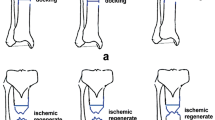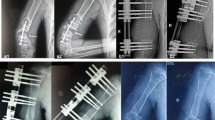Abstract
Bone loss in the forearm results from high-energy trauma or follows non-union with infection. Ilizarov methodology provides stable fixation without implantation of permanent foreign bodies while permitting wrist and elbow movement. We are reporting our experience using distraction osteogenesis in the treatment of traumatic bone loss in the forearm. From 1991 to 2000, 11 consecutive patients with traumatic forearm bone loss were treated with Ilizarov ring fixation. Records were reviewed retrospectively. All patients were contacted 2-10 years after surgery at the Ilizarov Clinic in Lecco, Italy. Eleven atrophic non-unions with bone loss were treated. The time from injury to Ilizarov treatment averaged 2.1 years. Follow-up averaged 6.2 years. The union rate with Ilizarov treatment alone was 64%. Thirty-six percent of the patients were converted to a hypertrophic non-union and underwent compression plating. The overall rate of union was 100%. There were four unplanned reoperations and no refractures, neurovascular injuries or deep infections. Three patients had significant limitations of wrist function. Nine patients described their function as excellent. Ilizarov fixation with bone transport is a viable treatment option for atrophic forearm non-unions with bone loss. Treatment resulted in ablation of infection, healing of atrophic non-unions with minimal complications and early extremity use.
Résumé
Les pertes de substance osseuses à l’avant-bras résultent d’un traumatisme à haute énergie ou d’une pseudarthrose septique. La méthode d’Ilizarov avec transport osseux donne une fixation stable permettant une mobilisation du poignet et du coude sans implantation permanente de matériel. De 1991 à 2000 11 patients consécutifs présentant une pseudarthrose atrophique avec perte de substance osseuse de l’avant-bras ont été traité ainsi et revus rétrospectivement 2 à 10 ans après. Le délai entre le traumatisme et le traitement étudié était en moyenne de 2,1 ans et le suivi moyen de 6,2 ans. Il y avait 64% de consolidation après traitement simple par la méthode d’Ilizarov et chez les autres patients elle avait conduit à une pseudarthrose hypertrophique nécessitant ensuite une ostéosynthèse en compression par plaque vissée. Quatre réinterventions non prévues ont été nécessaires. Le taux total de consolidation était de 100%. Il n’y avait pas de fracture itérative ni de complication vasculo-nerveuse ni d’infection profonde. Trois patients avaient une limitation nette de la fonction du poignet. Neuf patients décrivaient leur fonction comme excellente. La méthode d’Ilizarov est une bonne option thérapeutique pour les pseudarthrose atrophiques de l’avant-bras avec perte de substance osseuse. Elle permet le traitement de l’infection, la consolidation osseuse avec un minimum de complications et un recouvrement rapide de la fonction.

Similar content being viewed by others
References
Burwell HN, Charnley AD (1964) Treatment of forearm fractures in adults with particular reference to plate fixation. J Bone Joint Surg Br 46:404–425
Catagni MA, Guerreschi F, Holman JA, Cattaneo R (1994) Distraction osteogenesis in the treatment of stiff hypertrophic non-unions using the Ilizarov apparatus. Clin Orthop Relat Res 301:159–163
Catagni MA, Malzev V, Kirienko A (2004) Advances in Ilizarov apparatus assembly. Il quadratino, Italy
Cattaneo R, Villa A, Catagni MA, Bell D (1990) Lengthening of the humerus using the Ilizarov technique. Description of the method and report of 43 cases. Clin Orthop Relat Res 250:117–124
Christensen NE (1976) Technique, errors and safeguards in modern Kuntscher nailing. Clin Orthop Relat Res 115:182–188
Esser RD (1996) Treatment of a bone defect of the forearm by bone transport. A case report. Clin Orthop Relat Res 326:221–224
Ilizarov GA (1992) Transosseous osteosynthesis. Theoretical and clinical aspects of the regeneration and growth of tissue. Springer-Verlag-Heidelberg
Jupiter JB, Ruedi T (1992) Intraoperative distraction in the treatment of complex non-unions of the radius. J Hand Surg [Am] 17(3):416–422
Jupiter JB, Gerhard HJ, Guerrero J, Nunley JA, Levin LS (1997) Treatment of segmental defects of the radius with use of the vascularized osteoseptocutaneous fibular autogenous graft. J Bone Joint Surg Am 79(4):542–550
Lane JM, Bostrom MP (1998) Bone grafting and new composite biosynthetic graft materials. Instr Course Lect 47:525–534
Mack GR, Lichtman DM, MacDonald RI (1979) Fibular autografts for distal defects of the radius. J Hand Surg [Am] 4(6):576–583
Pavolini B, Maritato M, Turelli L, D’Arienzo M (2000) The Ilizarov fixator in trauma: a 10-year experience. J Orthop Sci 5(2):108–113
Saleh M, Yang L, Sims M (1999) Limb reconstruction after high energy trauma. Br Med Bull 55(4):870–884
Scaglietti O, Stringa G, Mizzau M (1965) Bone grafting in non-union of the forearm. Clin Orthop Relat Res 43:65–76
Singer BR, McLauchlan GJ, Robinson CM, Christie J (1998) Epidemiology of fractures in 15,000 adults: the influence of age and gender. J Bone Joint Surg Br 80(2):243–248
Street DM (1986) Intramedullary forearm nailing. Clin Orthop Relat Res 212:219–230
Stern PJ, Drury WJ (1983) Complications of plate fixation of forearm fractures. Clin Orthop Relat Res 175:25–29
Villa A, Paley D, Catagni MA, Bell D, Cattaneo R (1990) Lengthening of the forearm by the Ilizarov technique. Clin Orthop Relat Res 250:125–137
Weiland AJ, Phillips TW, Randolph MA (1984) Bone grafts: a radiologic, histologic, and biomechanical model comparing autografts, allografts, and free vascularized bone grafts. Plast Reconstr Surg 74(3):368–379
Wei SY, Born CT, Abene A, Ong A, Hayda R, DeLong WG Jr (1999) Diaphyseal forearm fractures treated with and without bone graft. J Trauma 46(6):1045–1048
Author information
Authors and Affiliations
Corresponding author
Additional information
The authors did not receive grants or outside funding in support of their research preparation of this manuscript.
Rights and permissions
About this article
Cite this article
Smith, W.R., Elbatrawy, Y.A., Andreassen, G.S. et al. Treatment of traumatic forearm bone loss with Ilizarov ring fixation and bone transport. International Orthopaedics (SICOT) 31, 165–170 (2007). https://doi.org/10.1007/s00264-006-0172-1
Received:
Accepted:
Published:
Issue Date:
DOI: https://doi.org/10.1007/s00264-006-0172-1




